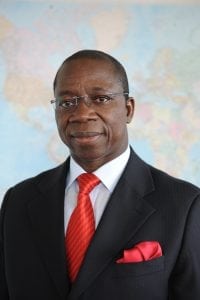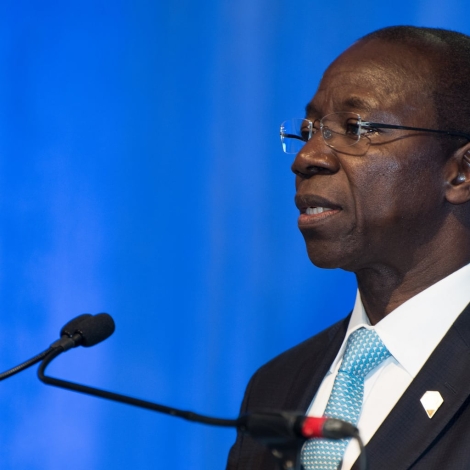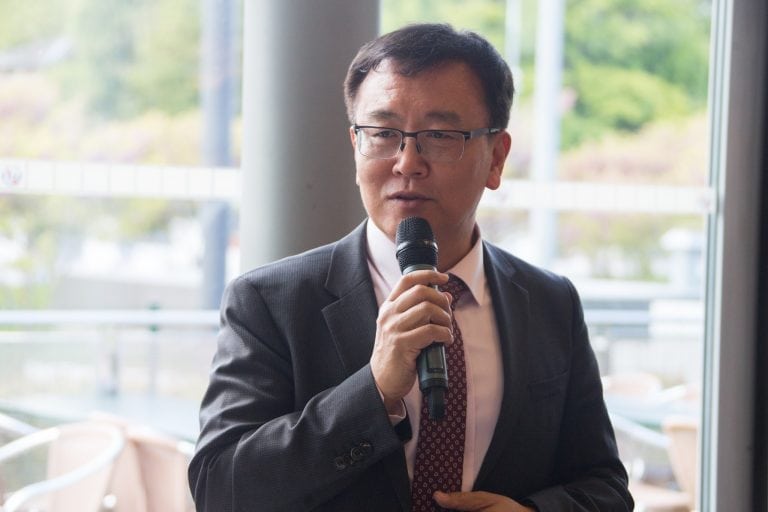 Brahima Sanou has taken the wheel at the Telecommunication Development Bureau of the International Telecommuniction Union (ITU) at a time when the world is adopting mobile communications and coming online. More people than ever before have mobile phones and Internet access through mobile data subscriptions or desktop connections. At the same time, however, the danger of a digital divide persists between people with means and people who cannot afford access to communications technology.
Brahima Sanou has taken the wheel at the Telecommunication Development Bureau of the International Telecommuniction Union (ITU) at a time when the world is adopting mobile communications and coming online. More people than ever before have mobile phones and Internet access through mobile data subscriptions or desktop connections. At the same time, however, the danger of a digital divide persists between people with means and people who cannot afford access to communications technology.
Since his election in 2011 to helm the BDT, as the bureau is called, Mr. Sanou has overseen the work to deliver digital benefits to the world’s underserved. Notable programs under Mr. Sanou’s purview include the m-Powering Development Initiative that energizes healthcare, education and business services through the power of mobile platforms; the Smart Sustainable Development Model initiative, which adds digital efficiency to disaster management and sustainable development; and the ITU Academy, a resource for ICT education.
Before assuming his role at the bureau, Mr. Sanou led a 30-year career in the ICT sector, starting in his home country of Burkina Faso. We asked Brahima Sanou five questions.
E4C: What obstacles do you see to connectivity, Internet access and telecommunications in developing countries?
BS: The role of information and communication technologies (ICTs) in helping to achieve the Sustainable Development Goals (SDGs) is gaining wide recognition. All three pillars of sustainable development – economic development, social inclusion and environmental protection – are accelerated and strengthened through ICTs.
Mobile broadband is booming and promises to reach more people, more rapidly than any other technology in history, while the spread of 3G and 4G networks across the world has brought the Internet to more and more people.
All three pillars of sustainable development – economic development, social inclusion and environmental protection – are accelerated and strengthened through ICTs.
In developing countries, the main obstacle to connectivity, access to Internet and telecommunications services is limited investment in ICT infrastructure. The situation is particularly critical in rural and remote areas where infrastructure developers and service providers may not be willing to invest their funds due to low returns [on investments]. And in areas where investments are possible, issues such as lack of electricity compound the problem further.
In 2016, mobile broadband networks covered 84 percent of the world’s population. Yet with 47.1 percent of Internet user penetration, the number of Internet users remains well below the number of people with network access. While network deployment is crucial, the high cost of mobile handsets, connection charges and poor quality of service are serious obstacles to getting more people to enter the digital world.
Access to the Internet is not enough; broadening ICT education is critical in helping people acquire the skills they need to take full advantage.
The expansion of the digital economy worldwide has increased the need for people to develop an array of digital skills. A lack of digital skills is a significant barrier to Internet adoption and use, which ultimately leads to deepen the digital divide. In addition, the kind of digital skills required to successfully navigate the digital economy is dramatically different today than the concepts of basic digital literacy that existed even five years ago. Access to the Internet is not enough; broadening ICT education to include all levels of education is critical in helping people acquire the skills they need to take full advantage of the Internet.
The benefits of the digital economy are still unavailable to over half of the world’s population. The offline population – 3.9 billion people globally – is disproportionately female, elderly, less educated, lower income and rural. Education and income levels are strong determinants of whether or not people use the Internet.
E4C: How is ITU supporting the expansion of telecommunications worldwide, especially among low-income populations?
BS: As the ICT sector continues to broaden and to converge with other sectors, collaboration becomes crucial.
ITU is conscious of its responsibility and capabilities to be a partner in innovation and development – and our work aims to reach that goal and build the basis for the next frontiers. We realize that our actions need to go beyond the ICT sector to take into account the ICT ecosystem. This is a new ecosystem, where ICTs are about streamlining government processes, bringing education and health to the people in need in order to create national cohesion, inclusiveness and economic growth. We are building open and frank conversations and collaboration across the sectors on the huge opportunities of the ICT sector in the digital economy and how we should work together to tap into them for business and development.
ITU also fosters key strategic dialogues including the Global Symposium for Regulators, delivering best practice guidelines on essential regulatory and policy issues and approaches.
ITU is working with partners to see how frontier technologies like artificial intelligence can help address poverty, hunger, education and healthcare.
Innovation, technology and network development are an important part of the conversation at the World Telecommunication Development Conference, which will be held in Buenos Aires, Argentina, from 9 to 20 October 2017.
ITU is working with partners to see how best new frontier technologies like artificial intelligence can assist global efforts to address poverty, hunger, education, healthcare, protection of our environment and accelerate progress towards a dignified life, in peace and prosperity, for all people.
ITU is engaging more and more with regional and international organizations, particularly with other UN agencies.
In the health sector ITU is working with the World Health Organization (WHO) on ways of using ICTs to improve universal health coverage. The Be He@lthy, Be Mobile initiative, which is global program jointly run by ITU and WHO, harnesses the power and reach of mobile phones to send health messages on how to prevent, treat and manage non-communicable diseases, thereby empowering and educating people to make healthier lifestyle choices.
For many developing countries, the speed of technological advances has outpaced the ability of policy-makers, the private sector and academia to react to these changes.
In education, ITU is working with the United Nations Education, Scientific and Cultural Organization (UNESCO) to foster innovation in the education sector and facilitate the use of mobile technology for learning.
In the area of agriculture, ITU has worked with the Food and Agricultural Organization (FAO) to develop an e-Agriculture Strategy Guide to help States adopt a strategic approach in making the best use of ICT developments in agriculture.
Access to and the use of ICT services bring innumerable social opportunities and help stimulate the economic growth of all nations, thereby benefiting the daily lives of all citizens.
For many developing countries, the speed of technological advances has often outpaced the ability of policy-makers, private sector players and institutions of higher learning to absorb and react to these changes. There is no doubt that our ability to leverage the benefits of ICTs depends upon our capacity to learn and acquire new knowledge. With that in mind, the ITU Academy was established in 2011. ITU Academy programs are designed to equip participants with the specialist knowledge and tools they need to find their way around the fast-evolving domain of telecommunications/ICT, and to use the skills and related technology for the creation of a knowledge society.
In 2011, ITU’s Telecommunication Development Bureau launched two initiatives to promote the use of ICTs for sustainable development. The M-Powering Development Initiative seeks to serve as an international, multi-stakeholder platform in order to leverage the phenomenal growth of mobile and the fact that this powerful technology is available in most rural and remote areas, delivering unprecedented computing power to individuals and empowering development in areas such as healthcare, education, agriculture, commerce, banking, and so on. The Smart Sustainable Development Initiative seeks to link ICT for Development (ICT4D) with ICT for Disaster Management (ICT4DM). ITU firmly believes that integrating ICTs into disaster management programmes can boost the ability of governments and other disaster relief organizations to respond before and after a disaster strikes in order to save lives. Through ICTs for disaster management, local communities can be able to respond and rebuild more easily when disasters strike.
E4C: What are some of the promising products and projects working to connect places with limited access to ICTs?
BS: ITU has several projects around the world, which are being implemented or have been implemented, with the objective of delivering Internet to places with little or no access.
Broadband Wireless Network projects are being developed to implement wireless broadband connectivity and ICT applications that will provide free or low cost digital access for schools and hospitals, and for underserved populations in rural and remote areas. Access to the Internet allows citizens to access basic services such as education and health care and is helping to lift people out of poverty through e-commerce and job growth. Nowhere else is this more pertinent than in rural and remote areas.
The Connect A School, Connect A Community Projects have been implemented to improve ICT access and use by school children and members of local communities. At the centers, students, youth and members of the local community are trained on how to use computers and are given courses for basic digital literacy needed to access information online. Students have found the centers particularly useful as they are now able to do online research to widen their knowledge of various subjects taught in school. They have also been able to transfer the computer and Internet knowledge they have gained back to their families and communities, allowing them to use e-commerce platforms to do business and thus expand their family’s incomes. ITU has implemented such projects in Niger, Gambia, Comoros, State of Palestine, Lesotho, Sri Lanka, Sierra Leone and Tanzania.
E4C: What are some of the encouraging statistics relevant to ICT4D that you are seeing now?
BS: ITU recently released the latest global ICT statistics with the publication of the ICT Facts and Figures 2017. The publication highlights the following positive ICT development trends:
New data show that young people are at the forefront of today’s information society: 70 percent of the global population aged 15-24 are using the Internet. This means that in a majority (104) of countries more than 80 percent of the people in the age range 15-24 use the Internet. Moreover, the percentage of Internet users in the age range 15-24 is remarkably higher than the percentage of Internet users in the whole population. The high Internet uptake by the youth in the developing world is a positive finding that allows us to be optimistic about future ICT developments.
The high Internet uptake by the youth in the developing world allows us to be optimistic about future ICT developments.
Today’s ICT development is driven by the spread of mobile-broadband services. The growth of mobile-broadband has largely outpaced that of fixed-broadband, while mobile-broadband prices have dropped by 50 percent on average over the last three years. These factors have resulted in about half of the world’s population getting online and broadband services being available at much higher speeds. The number of subscriptions has grown by more than 20% annually in the last 5 years globally, and there are 4.3 billion mobile-broadband subscriptions in the world today. In parallel, there has been a remarkable reduction in mobile-broadband prices. The development of mobile-broadband is contributing to bringing new people online, particularly in developing countries where fixed-broadband connectivity may be limited.
Mobile-broadband prices, as a percentage of gross national income per capita, dropped by half between 2013 and 2016. Mobile-broadband is more affordable than fixed-broadband in most developing countries.
The number of fixed-broadband subscriptions has increased by 9 percent annually in the last five years with up to 330 million subscriptions added.
There has been an increase in high-speed fixed-broadband subscriptions in parallel to the growth in the number of fiber connections. Most of the increase in high-speed fixed broadband subscriptions in developing countries can be attributed to China, which accounts for 80 percent of all fixed-broadband subscriptions at 10 Mbit/s or above in the developing world.
Mobile-broadband prices, as a percentage of gross national income per capita, dropped by half between 2013 and 2016.
While the Internet user gender gap has narrowed in most regions since 2013, the proportion of men using the Internet remains slightly higher than the proportion of women using the Internet in two-thirds of countries worldwide. In 2017, the global Internet penetration rate for men stands at 50.9 percent compared to 44.9 percent for women. The Americas is the only region where the number of women using the Internet is higher than that of men. In the region, Internet usage among women stands at 66.7 percent compared to 65.1 percent for men.
ITU has contributed to the unprecedented development of ICTs worldwide and the transformation they have brought to society.
As ICTs continue to be a key enabler of economic and social development, ITU plays a pivotal role in the global efforts to bridge the digital divide and foster an inclusive digital economy.

